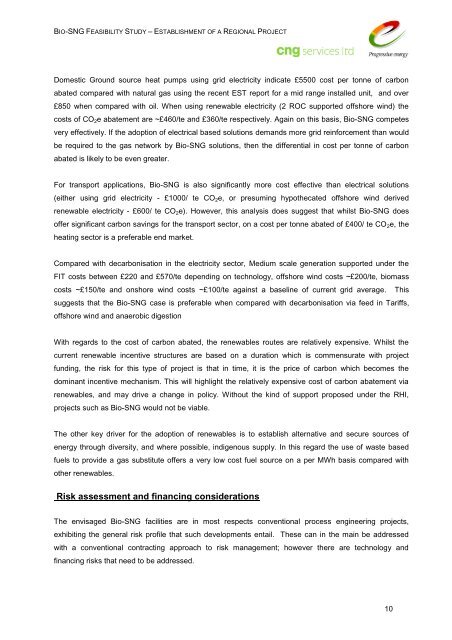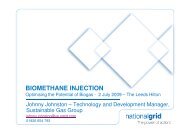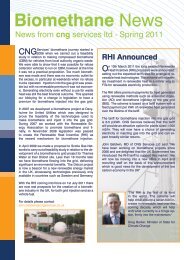Bio-SNG - CNG Services
Bio-SNG - CNG Services
Bio-SNG - CNG Services
You also want an ePaper? Increase the reach of your titles
YUMPU automatically turns print PDFs into web optimized ePapers that Google loves.
BIO-<strong>SNG</strong> FEASIBILITY STUDY – ESTABLISHMENT OF A REGIONAL PROJECTDomestic Ground source heat pumps using grid electricity indicate £5500 cost per tonne of carbonabated compared with natural gas using the recent EST report for a mid range installed unit, and over£850 when compared with oil. When using renewable electricity (2 ROC supported offshore wind) thecosts of CO 2 e abatement are ~£460/te and £360/te respectively. Again on this basis, <strong>Bio</strong>-<strong>SNG</strong> competesvery effectively. If the adoption of electrical based solutions demands more grid reinforcement than wouldbe required to the gas network by <strong>Bio</strong>-<strong>SNG</strong> solutions, then the differential in cost per tonne of carbonabated is likely to be even greater.For transport applications, <strong>Bio</strong>-<strong>SNG</strong> is also significantly more cost effective than electrical solutions(either using grid electricity - £1000/ te CO 2 e, or presuming hypothecated offshore wind derivedrenewable electricity - £600/ te CO 2 e). However, this analysis does suggest that whilst <strong>Bio</strong>-<strong>SNG</strong> doesoffer significant carbon savings for the transport sector, on a cost per tonne abated of £400/ te CO 2 e, theheating sector is a preferable end market.Compared with decarbonisation in the electricity sector, Medium scale generation supported under theFIT costs between £220 and £570/te depending on technology, offshore wind costs ~£200/te, biomasscosts ~£150/te and onshore wind costs ~£100/te against a baseline of current grid average. Thissuggests that the <strong>Bio</strong>-<strong>SNG</strong> case is preferable when compared with decarbonisation via feed in Tariffs,offshore wind and anaerobic digestionWith regards to the cost of carbon abated, the renewables routes are relatively expensive. Whilst thecurrent renewable incentive structures are based on a duration which is commensurate with projectfunding, the risk for this type of project is that in time, it is the price of carbon which becomes thedominant incentive mechanism. This will highlight the relatively expensive cost of carbon abatement viarenewables, and may drive a change in policy. Without the kind of support proposed under the RHI,projects such as <strong>Bio</strong>-<strong>SNG</strong> would not be viable.The other key driver for the adoption of renewables is to establish alternative and secure sources ofenergy through diversity, and where possible, indigenous supply. In this regard the use of waste basedfuels to provide a gas substitute offers a very low cost fuel source on a per MWh basis compared withother renewables.Risk assessment and financing considerationsThe envisaged <strong>Bio</strong>-<strong>SNG</strong> facilities are in most respects conventional process engineering projects,exhibiting the general risk profile that such developments entail. These can in the main be addressedwith a conventional contracting approach to risk management; however there are technology andfinancing risks that need to be addressed.10









